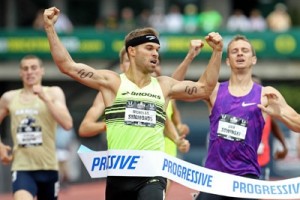Federal Judge Dismisses Nick Symmonds’ Run Gum Lawsuit, USATF and USOC Can Restrict Non-Apparel Logos at Olympic Trials
by LetsRun.com
May 12, 2016
U.S. district judge Michael J. McShane has dismissed Run Gum’s Olympic Trials logo restriction lawsuit (aka the Nick Symmonds lawsuit) vs. the USOC and USATF on summary judgment a Rule 12 (b) (6) motion to dismiss meaning USATF will be able to prevent athletes from having non-apparel logos on their jerseys at this summer’s Olympic Trials barring an appeal by Run Gum. (h/t to Pete Danko for the ruling).
In his ruling, Judge McShane wrote that the 1978 Amateur Sports Act gives the USOC and USATF implied immunity from the antitrust violations alleged by Run Gum and that the USOC and USATF were acting reasonably within this implied immunity to try to finance Team USA by restricting the logos.
Judge McShane wrote, “I find that the Regulations are a proper exercise of their (USATF’s and USOC’s) statutory authority. Despite Run Gum’s contentions to the contrary, immunizing the Regulations from antitrust liability does not unmoor the USOC from all responsibility under the Sherman Act. Rather, it allows USOC and USATF to preclude athletes from becoming human billboards at the Trials — a ban which is necessary to finance Team USA.”
The current logo restrictions in place say athletes can only have one non-club logo on their jersey and it can only be the logo of their apparel manufacturer. USATF and the USOC make no attempt to monetize this logo to fund Team USA as the athletes determine who their apparel manufacturer is. Symmonds wanted athletes to be able to put non-apparel manufacturers on this logo.
The judge ruled that allowing non-apparel manufacturers would hurt USATF and the USOC’s ability to raise sponsorships writing, “The logo restrictions in this case directly implicate USOC’s ability to generate revenue for the United States Olympic Team; allowing any company to advertise on competitor apparel would unduly interfere with USOC’s fundraising mission. First, the Regulations prevent a dilution of the Olympic brand. The Regulations permit the USOC and USATF to play a gatekeeping function which preserves the exclusivity — and thus value — of the Olympic symbols and name. By strictly limiting the advertisements that can appear on the field of competition itself, the Defendants can control the use of the Olympic brand and preserve the integrity of their primary fundraising mechanism. Second, the Regulations bolster the value of USOC’s and USATF’s corporate sponsorships. If, instead of purchasing an official sponsorship through USATF, would-be advertisers could instead place their logos directly on high-profile athletes, the value of these corporate sponsorships would necessarily decrease. Accordingly, the Regulations are necessary to implement the clear intent of Congress and to make the ASA’s statutory scheme work. Without them, USOC’s revenue-generating capabilities would be compromised in a way that is plainly repugnant to the text and purpose of the Act.”
LRC Quick Take: What Will Athletes Do Next?
This may end the legal battle, but will the athletes stand up for their right to determine what goes on one small logo on their jersey? Most athletes at the Olympic Trials get almost no funding from the USATF or USOC and even pay to enter the meet. The judge ruled that allowing a non-apparel manufacturer in the place of where an apparel manufacturer logo is would hurt USATF and the USOC’s ability to raise money. That could be the case, but what is more debatable is whether logo restrictions benefit Olympic athletes as a whole. An athlete who doesn’t have an apparel sponsorship but can get Run Gum or Chipotle to pay them $500 for a logo is worse off because of this ruling.
If Olympic athletes as a whole are financially better off with USATF and USOC controlling which logos appear on an athlete’s jersey, then it’s not much of a leap to say that NO logos — including apparel logos — should be allowed. Clearly, the USOC and USATF know that athletes would not stand for that, as it would hurt athletes’ bottom lines. Will the athletes allow this to stand? Just because USATF and the USOC can legally do something doesn’t mean it is prudent to do it.
Full text of the ruling below.
Talk about this decision on our messageboard:
MB: Nick Symmonds’ Run Gum Lawsuit Tossed Out, USATF and USOC Can Restrict Non-Apparel Logos at Olympic Trials








